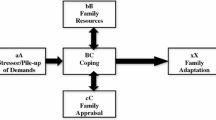Abstract
The behavioural phenotype of 30 fragile-X, 35 Prader-Willi and 35 Williams-Beuren syndrome children was explored using a psychometric approach. Results confirmed some distinct behaviours as syndrome-specific, but revealed a high degree of within-syndrome variability and overlap between syndromes as well. Parental stress was high in each of the groups, but was mediated by maternal dissatisfaction with family relationships. A multi-method approach with detailed syndrome-specific observations is recommended for further research.
Similar content being viewed by others
References
Abidin R (1990) Parenting Stress Index. Pediatric Psychology Press, Charlottesville
Beresford B (1994) Resources and strategies: How parents cope with the care of a disabled child. Journal of Child Psychology and Psychiatry 35:171–209
Clarke D, Waters J, Corbett J (1989) Adults with Prader-Willi syndrome: Abnormalities of sleep and behaviour. Journal of the Royal Society of Medicine 82:21–24
Clarke D, Boer, H, Chung M, Sturmey P, Webb T (1996) Maladaptive behavior in Prader-Willi syndrome in adult life. Journal of Intellectual Disability Research 40:159–165
Deal A, Trivette C, Dunst C (1988) Family Functioning Scale. In: Dunst C Trivette C, Deal A (eds) Enabling and empowering families: Principles and guidelines for practice. Brookline Books, Cambridge, pp 179–184
Dilts C, Morris C, Leonard C (1990) Hypothesis for development of a behavioral phenotype in Williams syndrome. American Journal of Medical Genetics 6:126–131
Döpfner M, Berner W, Fleischmann T, Schmidt M (1993) Verhaltensbeurteilungsbogen für Vorschulkinder (VBV 36). Beltz Test, Weinheim
Dykens E (1995) Measuring behavioral phenotypes: Provocations from the “new genetics”. American Journal of Mental Retardation 99:522–532
Dykens E, Hodapp R, Walsh K, Nash L (1992) Adaptive and maladaptive behavior in Prader-Willi syndrome. Journal of the American Academy of Child and Adolescent Psychiatry 31:1131–1136
Einfeld S, Hall W (1992) Behavior phenotype of the fragile X syndrome. American Journal of Medical Genetics 43:56–60
Einfeld S, Hall W, Levy F (1991) Hyperactivity and the fragile X syndrome. Journal of Abnormal Child Psychology 19:283–284
Einfeld S, Tonge B, Florio T (1994) Behavioural and emotional disturbance in fragile X syndrome. American Journal of Medical Genetics 51:386–391
Hagerman R, Sobesky W (1989) Psychopathology in fragile X syndrome. American Journal of Orthopsychiatry 59:142–152
Holm V, Cassidy S, Butler M, Hanchett J, Greenswag L, Whitman B, Greenberg F (1993) Prader-Willi syndrome: Consensus diagnostic criteria. Pediatrics 91:398–402
Innocenti M, Huh K, Boyce G (1992) Families of children with disabilities: Normative data and other considerations on parenting stress. Topics in Early Childhood Special Education 12:403–427
O'Brien G (1992a) Behavioural phenotypes and their measurement. Developmental Medicine and Child Neurology 34:365–367
O'Brien G (1992b) Behavioural phenotypy in developmental psychiatry. European Child and Adolescent Psychiatry 1:1–61
Remschmidt H, Walter R (1990) Psychische Auffälligkeiten bei Schulkindern. Hogrefe, Göttingen
Sarimski K (1993) Belastung von Muttern behinderter Kleinkinder. Frühförderung interdisziplinär 12:156–164
Trivette C, Dunst C, Deal A, Hamer W, Propst S (1992) Assessing family strengths and family functioning style. Topics in Early Childhood Special Education 10:16–34
Tunali B, Power T (1993) Creating satisfaction: A psychological perspective on stress and coping in families of handicapped children. Journal of Child Psychology and Psychiatry 34:945–957
Turk J (1992) The fragile X syndrome. On the way to a behavioural phenotype. British Journal of Psychiatry 160:24–35
Udwin O, Yule W, Martin N (1987) Cognitive abilities and behavioural characteristics of children with idiopathic in fantile hypercalcaemia. Journal of Child Psychology and Psychiatry 28:297–309
Author information
Authors and Affiliations
Rights and permissions
About this article
Cite this article
Sarimski, K. Behavioural phenotypes and family stress in three mental retardation syndromes. European Child & Adolescent Psychiatry 6, 26–31 (1997). https://doi.org/10.1007/BF00573637
Received:
Accepted:
Issue Date:
DOI: https://doi.org/10.1007/BF00573637




